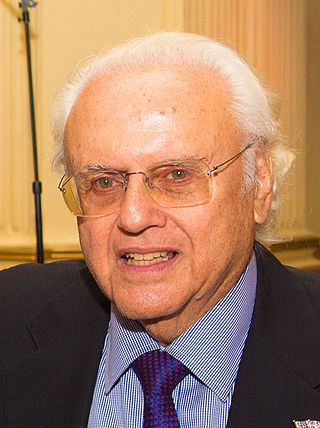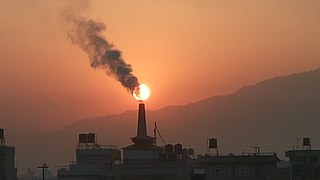
The Great Salt Lake is the largest saltwater lake in the Western Hemisphere and the eighth-largest terminal lake in the world. It lies in the northern part of the U.S. state of Utah and has a substantial impact upon the local climate, particularly through lake-effect snow. It is a remnant of Lake Bonneville, a prehistoric body of water that covered much of western Utah.

Tooele is a city in Tooele County in the U.S. state of Utah. The population was 35,742 at the 2020 census. It is the county seat of Tooele County. Located approximately 40 minutes southwest of Salt Lake City, Tooele is known for Tooele Army Depot, for its views of the nearby Oquirrh Mountains and the Great Salt Lake.

ASARCO is a mining, smelting, and refining company based in Tucson, Arizona, which mines and processes primarily copper. The company has been a subsidiary of Grupo México since 1999.
The Renco Group, Inc. is an American New York City-based holding company controlled by Ira Rennert that invests in other companies across a range of industries.

Ira Leon Rennert is an American billionaire businessman, and the chairman and CEO of Renco Group.

ATI Inc. is an American producer of specialty materials headquartered in Dallas, Texas. ATI produces metals including titanium and titanium alloys, nickel-based alloys and superalloys, stainless and specialty steels, zirconium, hafnium, and niobium, tungsten materials, forgings and castings.

Industrial wastewater treatment describes the processes used for treating wastewater that is produced by industries as an undesirable by-product. After treatment, the treated industrial wastewater may be reused or released to a sanitary sewer or to a surface water in the environment. Some industrial facilities generate wastewater that can be treated in sewage treatment plants. Most industrial processes, such as petroleum refineries, chemical and petrochemical plants have their own specialized facilities to treat their wastewaters so that the pollutant concentrations in the treated wastewater comply with the regulations regarding disposal of wastewaters into sewers or into rivers, lakes or oceans. This applies to industries that generate wastewater with high concentrations of organic matter, toxic pollutants or nutrients such as ammonia. Some industries install a pre-treatment system to remove some pollutants, and then discharge the partially treated wastewater to the municipal sewer system.

Kennecott Utah Copper LLC (KUC), a division of Rio Tinto Group, is a mining, smelting, and refining company. Its corporate headquarters are located in South Jordan, Utah. Kennecott operates the Bingham Canyon Mine, one of the largest open-pit copper mines in the world in Bingham Canyon, Salt Lake County, Utah. The company was first formed in 1898 as the Boston Consolidated Mining Company. The current corporation was formed in 1989. The mine and associated smelter produce 1% of the world's copper.

The Bingham Canyon Mine, more commonly known as Kennecott Copper Mine among locals, is an open-pit mining operation extracting a large porphyry copper deposit southwest of Salt Lake City, Utah, in the Oquirrh Mountains. The mine is the largest human-made excavation, and deepest open-pit mine in the world, which is considered to have produced more copper than any other mine in history – more than 19,000,000 short tons. The mine is owned by Rio Tinto Group, a British-Australian multinational corporation. The copper operations at Bingham Canyon Mine are managed through Kennecott Utah Copper Corporation which operates the mine, a concentrator plant, a smelter, and a refinery. The mine has been in production since 1906, and has resulted in the creation of a pit over 0.75 miles (1,210 m) deep, 2.5 miles (4 km) wide, and covering 1,900 acres. It was designated a National Historic Landmark in 1966 under the name Bingham Canyon Open Pit Copper Mine. The mine experienced a massive landslide in April 2013 and a smaller slide in September 2013.

Chemetco was formerly one of the largest United States refiners of copper from recycled or residual sources.
The Doe Run Resources Corporation, known by the trade name The Doe Run Company, is a privately held natural resources company and global producer of lead, copper, and zinc concentrates. It owns four mills, six mines and a lead battery recycling plant, all in southeast Missouri, United States, and a subsidiary Fabricated Products Inc. with locations in Arizona and Washington. It also owns two former primary lead smelter sites in the U.S. that are currently being remediated. It is wholly owned by The Renco Group, Inc
RTI International Metals (RMI Titanium Company Inc., founded in 1950, is a leading US producer of titanium mill products and fabricated metal components for the global market. Through its various subsidiaries, RTI manufactures and distributes titanium and specialty metal mill products, extruded shapes, formed parts and engineered systems for aerospace, industrial, defense, energy, chemical, and consumer applications for customers around the world. The company is commonly referred to simply as RTI. The vice chairman, president, and chief executive officer was Dawne Hickton until 2015.
Wah Chang Corporation was an American manufacturing company in the metal or alloy industry based in Albany, Oregon in the United States. Since 2014, it is a business unit of Allegheny Technologies and makes corrosion-resistant metals, such as hafnium, niobium, titanium, vanadium, and zirconium.

Plants for the production of lead are generally referred to as lead smelters. Primary lead production begins with sintering. Concentrated lead ore is fed into a sintering machine with iron, silica, limestone fluxes, coke, soda ash, pyrite, zinc, caustics or pollution control particulates. Smelting uses suitable reducing substances that will combine with those oxidizing elements to free the metal. Reduction is the final, high-temperature step in smelting. It is here that the oxide becomes the elemental metal. A reducing environment pulls the final oxygen atoms from the raw metal.
This is a list of countries by titanium sponge production based on USGS figures. The production figures are for titanium sponge, units are in metric tons.

Exide was one of the world's largest producers, distributors and recyclers of lead-acid batteries. Lead-acid batteries are used in automobiles, golf carts, fork-lifts, electric cars and motorcycles. They are recycled by grinding them open, neutralizing the sulfuric acid, and separating the polymers from the lead and copper. In the US, 97 percent of the lead from car batteries is recycled - which is the highest recycling rate for any commodity. Most states require stores to take back old batteries.

Brine mining is the extraction of useful materials which are naturally dissolved in brine. The brine may be seawater, other surface water, groundwater, or hyper-saline solutions from several industries. It differs from solution mining or in-situ leaching in that those methods inject water or chemicals to dissolve materials which are in a solid state; in brine mining, the materials are already dissolved.

The Raritan Bay Slag Superfund Site consists of a seawall along the coast of the Raritan Bay in the Laurence Harbor section of Old Bridge Township, New Jersey, United States. The seawall itself is made of slag. In this seawall, are large concentrations of lead, antimony, arsenic, and copper. The lead in particular has contaminated the nearby soil and surface water. The slag deposits are a by-product from NL Industries, a lead smelting company, dumping its wastes in the Raritan River. The New Jersey Department of Environmental Protection (NJDEP) investigated the area and found large concentrations of metals to be dangerous to human health. The NJDEP called the United States Environmental Protection Agency (EPA) to investigate the area further, which resulted in some of the slag being physically removed and the toxic areas being fenced off.
The U.S. Smelting and Lead Refinery Inc. site, commonly known as USS Lead, is a superfund site located in East Chicago, which is located in northwest Indiana. The site includes part of the former USS Lead facility along with nearby commercial, municipal, and residential areas. Originally the site was used as a lead ore refinery with the surrounding businesses at the time performing similar operations. Through a history of redlining and racial discrimination brought on by the 1920 Urban Renewal Campaign, it is seen that East Chicago’s minority community is subject to the consequences of the contamination and has led to claims of environmental racism. The primary contaminants of concern for this area are lead and arsenic, both of which when in the human bloodstream, cause numerous health effects. The site is currently undergoing testing and remediation. This Superfund site is broken down into two Operable Units. The first, OU1, has been divided into three zones, these being the public housing complex and residential properties. OU2 includes soil at the former USS Lead facility, as well as groundwater in and around the site.

Zaporizhzhya Titanium-Magnesium Plant is the only manufacturer of titanium sponge in Europe. ZTMP is located in Zaporizhzhya, Ukraine, and the plant produces titanium ingots, as well as slabs that are widely used as a structural material in nuclear power, chemical engineering, shipbuilding, and many other industries.















